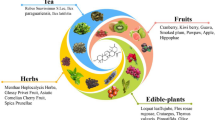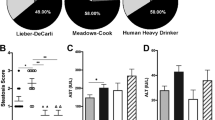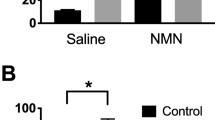Abstract
Alcohol abuse has attracted public attention and long-term alcohol exposure can lead to alcohol-featured non-ischemic dilated cardiomyopathy. However, the precise underlying mechanisms of alcoholic cardiomyopathy remain to be elucidated. This study aimed to comprehensively characterize alcohol abuse-mediated effects on downstream metabolites and genes transcription using a multi-omics strategy. We established chronic ethanol intoxication model in adult male C57BL/6 mice through 8 weeks of 95% alcohol vapor administration and performed metabolomics analysis, mRNA-seq and microRNA-seq analysis with myocardial tissues. Firstly, ethanol markedly induced ejection fraction reductions, cardiomyocyte hypertrophy, and myocardial fibrosis in mice with myocardial oxidative injury. In addition, the omics analysis identified a total of 166 differentially expressed metabolites (DEMs), 241 differentially expressed genes (DEGs) and 19 differentially expressed microRNAs (DEmiRNAs), respectively. The results highlighted that alcohol abuse mainly interfered with endogenous lipids, amino acids and nucleotides production and the relevant genes transcription in mice hearts. Based on KEGG database, the affected signaling pathways are primarily mapped to the antigen processing and presentation, regulation of actin cytoskeleton, AMPK signaling pathway, tyrosine metabolism and PPAR signaling pathway, etc. Furthermore, 9 hub genes related to oxidative stress from DEGs were selected based on function annotation, and potential alcoholic cardiotoxic oxidative stress biomarkers were determined through establishing PPI network and DEmiRNAs-DEGs cross-talk. Altogether, our data strongly supported the conclusion that ethanol abuse characteristically affected amino acid and energy metabolism, nucleotide metabolism and especially lipids metabolism in mice hearts, and underlined the values of lipids signaling and oxidative stress in the treatment strategies.







Similar content being viewed by others
Data availability
The datasets obtained and analyzed in this study are available from the corresponding author on reasonable request.
References
Klatsky AL (2002) Alcohol and cardiovascular diseases: a historical overview. Ann N Y Acad Sci 957:7–15. https://doi.org/10.1111/j.1749-6632.2002.tb02901.x
Gavazzi A et al (2000) Alcohol abuse and dilated cardiomyopathy in men. Am J Cardiol 85(9):1114–8. https://doi.org/10.1016/s0002-9149(00)00706-2
Guzzo-Merello G et al (2014) Alcoholic cardiomyopathy. World J Cardiol 6(8):771–781. https://doi.org/10.4330/wjc.v6.i8.771
Piano MR, Phillips SA (2014) Alcoholic cardiomyopathy: pathophysiologic insights. Cardiovasc Toxicol 14(4):291–308. https://doi.org/10.1007/s12012-014-9252-4
Fernández-Solà J (2020) The effects of ethanol on the heart: alcoholic cardiomyopathy. Nutrients 12(2):572
Fernandez-Sola J (2015) Cardiovascular risks and benefits of moderate and heavy alcohol consumption. Nat Rev Cardiol 12(10):576–587
Laurent D, Edwards JG (2014) Alcoholic cardiomyopathy: multigenic changes underlie cardiovascular dysfunction. J Cardiol Clin Res 2(1):1022
Mirijello A et al (2017) Alcoholic cardiomyopathy: what is known and what is not known. Eur J Intern Med 43:1–5
Wishart DS et al (2007) HMDB: the human metabolome database. Nucl Acids Res 35(Database issue):D521–D526. https://doi.org/10.1093/nar/gkl923
Alexander D et al (2011) Metabolomic distinction and insights into the pathogenesis of human primary dilated cardiomyopathy. European J Clin Investig 41(5):527–538. https://doi.org/10.1111/j.1365-2362.2010.02441.x
Shi L et al (2006) The MicroArray Quality Control (MAQC) project shows inter- and intraplatform reproducibility of gene expression measurements. Nat Biotechnol 24(9):1151–1161. https://doi.org/10.1038/nbt1239
Ying S-Y, Chang DC, Lin S-L (2008) The microRNA (miRNA): overview of the RNA genes that modulate gene function. Mol Biotechnol 38(3):257–268
Sunkar R, Li Y-F, Jagadeeswaran G (2012) Functions of microRNAs in plant stress responses. Trends Plant Sci 17(4):196–203. https://doi.org/10.1016/j.tplants.2012.01.010
Bai M et al (2019) Integrated analysis of miRNA and mRNA expression profiles reveals functional miRNA-targets in development testes of small tail han sheep. G3 9(2):523–533. https://doi.org/10.1534/g3.118.200947
Liu X et al (2020) Pharmacological activation of CB2 receptor protects against ethanol-induced myocardial injury related to RIP1/RIP3/MLKL-mediated necroptosis. Mol Cell Biochem 474(1):1–14
Zhang D et al (2020) Cannabinoid 1 receptor antagonists play a neuroprotective role in chronic alcoholic hippocampal injury related to pyroptosis pathway. Alcohol Clin Exp Res 44(8):1585–1597
Zhu R et al (2022) Ethanol potentiates mirtazapine-induced cardiotoxicity by inducing dysfunctional autophagy via HMGB1-dependent Akt/mTOR signaling pathway. Toxicol Lett 358:27–39
Rogers J, Wiener SG, Bloom FE (1979) Long-term ethanol administration methods for rats: advantages of inhalation over intubation or liquid diets. Behav Neural Biol 27(4):466–486
Mouton AJ et al (2016) Alcohol vapor inhalation as a model of alcohol-induced organ disease. Alcohol Clin Exp Res 40(8):1671–1678
Dunn WB et al (2011) Procedures for large-scale metabolic profiling of serum and plasma using gas chromatography and liquid chromatography coupled to mass spectrometry. Nat Protoc 6(7):1060–1083
King AM et al (2019) Development of a rapid profiling method for the analysis of polar analytes in urine using HILIC-MS and ion mobility enabled HILIC-MS. Metabolomics 15(2):17. https://doi.org/10.1007/s11306-019-1474-9
Tsugawa H et al (2015) MS-DIAL: data-independent MS/MS deconvolution for comprehensive metabolome analysis. Nat Methods 12(6):523–6. https://doi.org/10.1038/nmeth.3393
Denoeud F et al (2008) Annotating genomes with massive-scale RNA sequencing. Genome Biol 9(12):R175. https://doi.org/10.1186/gb-2008-9-12-r175
Juhila J et al (2011) MicroRNA expression profiling reveals miRNA families regulating specific biological pathways in mouse frontal cortex and hippocampus. PLoS One 6(6):e21495. https://doi.org/10.1371/journal.pone.0021495
Trygg J, Wold S (2002) Orthogonal projections to latent structures (O-PLS). J Chemom J Chemom Soc 16(3):119–128
Teng M et al (2018) Metabolomics and transcriptomics reveal the toxicity of difenoconazole to the early life stages of zebrafish (Danio rerio). Aquat Toxicol 194:112–120
Enright AJ et al (2003) MicroRNA targets in Drosophila. Genome Biol 5(1):R1
Consortium, G.O. (2019) The gene ontology resource: 20 years and still GOing strong. Nucl Acids Res 47(D1):D330–D338
Kanehisa M et al (2008) KEGG for linking genomes to life and the environment. Nucl Acids Res 36(Database issue):D480–D484
Tsikas D (2017) Assessment of lipid peroxidation by measuring malondialdehyde (MDA) and relatives in biological samples: analytical and biological challenges. Anal Biochem 524:13–30. https://doi.org/10.1016/j.ab.2016.10.021
Junn E et al (2000) Vitamin D3 up-regulated protein 1 mediates oxidative stress via suppressing the thioredoxin function. J Immunol 164(12):6287–6295
Yang G et al (2014) Oxidative stress and inflammation modulate rev-erbα signaling in the neonatal lung and affect circadian rhythmicity. Antioxid Redox Signal 21(1):17–32. https://doi.org/10.1089/ars.2013.5539
Miyazaki M et al (2003) Identification and characterization of murine SCD4, a novel heart-specific stearoyl-CoA desaturase isoform regulated by leptin and dietary factors. J Biol Chem 278(36):33904–33911
Miyazaki M, Bruggink SM, Ntambi JM (2006) Identification of mouse palmitoyl-coenzyme a Delta9-desaturase. J Lipid Res 47(4):700–704
Simopoulos AP (2008) The importance of the omega-6/omega-3 fatty acid ratio in cardiovascular disease and other chronic diseases. Exp Biol Med 233(6):674–88. https://doi.org/10.3181/0711-mr-311
Zhou C et al (2018) CYP2J2-derived EETs attenuated ethanol-induced myocardial dysfunction through inducing autophagy and reducing apoptosis. Free Radic Biol Med 117:168–179. https://doi.org/10.1016/j.freeradbiomed.2018.02.009
Fox BM et al (2019) Metabolomics assessment reveals oxidative stress and altered energy production in the heart after ischemic acute kidney injury in mice. Kidney Int 95(3):590–610. https://doi.org/10.1016/j.kint.2018.10.020
Drake KJ et al (2012) Amino acids as metabolic substrates during cardiac ischemia. Exp Biol Med 237(12):1369–1378. https://doi.org/10.1258/ebm.2012.012025
Cai X et al (2021) Inhibition of miR-322–5p protects cardiac myoblast cells against hypoxia-induced apoptosis and injury through regulating CIAPIN1. J Cardiovasc Pharmacol 77(2):200–207. https://doi.org/10.1097/fjc.0000000000000949
Qin D et al (2016) MicroRNA-223–5p and -3p cooperatively suppress necroptosis in ischemic/reperfused hearts. J Biol Chem 291(38):20247–59. https://doi.org/10.1074/jbc.M116.732735
Marton A et al (2001) Anti-inflammatory effects of inosine in human monocytes, neutrophils and epithelial cells in vitro. Int J Mol Med 8(6):617–621
Hoffman M et al (2021) Cardiomyocyte krüppel-like factor 5 promotes de novo ceramide biosynthesis and contributes to eccentric remodeling in ischemic cardiomyopathy. Circulation 143(11):1139–1156. https://doi.org/10.1161/CIRCULATIONAHA.120.047420
Kyriazis ID et al (2021) KLF5 is induced by FOXO1 and causes oxidative stress and diabetic cardiomyopathy. Circ Res 128(3):335–357. https://doi.org/10.1161/CIRCRESAHA.120.316738
Ji R et al (2017) Increased de novo ceramide synthesis and accumulation in failing myocardium. JCI Insight. https://doi.org/10.1172/jci.insight.82922
Higgins AJ, Lees P (1984) The acute inflammatory process, arachidonic acid metabolism and the mode of action of anti-inflammatory drugs. Equine Vet J 16(3):163–175
Bekhite M et al (2021) The role of ceramide accumulation in human induced pluripotent stem cell-derived cardiomyocytes on mitochondrial oxidative stress and mitophagy. Free Radic Biol Med 167:66–80. https://doi.org/10.1016/j.freeradbiomed.2021.02.016
Tserng K-Y, Griffin RL (2004) Ceramide metabolite, not intact ceramide molecule, may be responsible for cellular toxicity. Biochem J 380(Pt 3):715–722
García-Ruiz C et al (1997) Direct effect of ceramide on the mitochondrial electron transport chain leads to generation of reactive oxygen species. Role of mitochondrial glutathione. J Biol Chem 272(17):11369–11377
Sugiura T, Waku K (2000) 2-Arachidonoylglycerol and the cannabinoid receptors. Chem Phys Lipids 108(1–2):89
Ma XL et al (1999) Inhibition of p38 mitogen-activated protein kinase decreases cardiomyocyte apoptosis and improves cardiac function after myocardial ischemia and reperfusion. Circulation 99(13):1685–91. https://doi.org/10.1161/01.cir.99.13.1685
See F et al (2004) p38 mitogen-activated protein kinase inhibition improves cardiac function and attenuates left ventricular remodeling following myocardial infarction in the rat. J Am Coll Cardiol 44(8):1679–89. https://doi.org/10.1016/j.jacc.2004.07.038
Fuentes N, Silveyra P (2019) Estrogen receptor signaling mechanisms. Adv Protein Chem Struct Biol 116:135–170. https://doi.org/10.1016/bs.apcsb.2019.01.001
Swirski FK, Nahrendorf M (2018) Cardioimmunology: the immune system in cardiac homeostasis and disease. Nat Rev Immunol 18(12):733–744. https://doi.org/10.1038/s41577-018-0065-8
Xin C et al (2020) Astilbin protects chicken peripheral blood lymphocytes from cadmium-induced necroptosis via oxidative stress and the PI3K/Akt pathway. Ecotoxicol Environ Safety 190:110064. https://doi.org/10.1016/j.ecoenv.2019.110064
Gonzalez-Juarbe N et al (2020) Influenza-Induced oxidative stress sensitizes lung cells to bacterial-toxin-mediated necroptosis. Cell Rep 32(8):108062. https://doi.org/10.1016/j.celrep.2020.108062
Qianru C et al (2021) Regulation of HS-induced necroptosis and inflammation in broiler bursa of fabricius by the miR-15b-5p/TGFBR3 axis and the involvement of oxidative stress in this process. J Hazard Mater 406:124682. https://doi.org/10.1016/j.jhazmat.2020.124682
Funding
This work was supported by the National Natural Science Foundation of China [Grant Nos. 81871525].
Author information
Authors and Affiliations
Contributions
Qiupeng Xue, Xiaochen Liu, Rongzhe Zhu and Xiaoru Dong concepted and designed the experiments; Qiupeng Xue, Rongzhe Zhu and Tianyi Zhang wrote the main manuscript text; Qiupeng Xue prepared figures and tables. All authors reviewed and approved the manuscript. Miss Liu has contributed to the conception and design of our experiments, and she has reviewed and approved the manuscript.
Corresponding author
Ethics declarations
Conflict of interest
The authors declare that they have no conflict of interest.
Ethical approval
All experimental procedures were conducted according to the protocols for animal experiments approved by the Ethical Review Committee at the School of Basic Medical Sciences, Fudan University, Shanghai, China (Approval No. 20180302–024).
Additional information
Publisher's Note
Springer Nature remains neutral with regard to jurisdictional claims in published maps and institutional affiliations.
Supplementary Information
Below is the link to the electronic supplementary material.
11010_2022_4592_MOESM1_ESM.docx
Supplementary file1: Fig. S1 A. QC results of samples processed for metabolomics. B. Hierarchical clustering analysis (HCA) of DEGs. Fig. S2 A. KEGG Enrichment Top 20 pathways of DEMs. B. Top 30 GO terms of DEmiRNAs-targeted genes. Fig. S3 A. qRT-PCR results of selected genes and miRNAs. (*p<0.0332, **p<0.0021, ***p<0.0002 vs CtrL, n≥3). B. GO term mitochondrial respiratory chain complex I gene set displayed in Gene Set Enrichment Analysis (GSEA). Fig. S4 Top 20 DEMs and DEGs correlation diagram.
Rights and permissions
Springer Nature or its licensor (e.g. a society or other partner) holds exclusive rights to this article under a publishing agreement with the author(s) or other rightsholder(s); author self-archiving of the accepted manuscript version of this article is solely governed by the terms of such publishing agreement and applicable law.
About this article
Cite this article
Xue, Q., Liu, X., Zhu, R. et al. Comprehensive analysis of transcriptomics and metabolomics to understand chronic ethanol induced murine cardiotoxicity. Mol Cell Biochem 478, 1345–1359 (2023). https://doi.org/10.1007/s11010-022-04592-0
Received:
Accepted:
Published:
Issue Date:
DOI: https://doi.org/10.1007/s11010-022-04592-0




